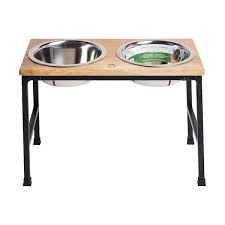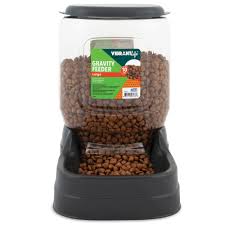The Benefits of Elevated Dog Bowls
Many pet owners are familiar with traditional dog bowls placed on the floor for feeding and watering their furry friends. However, elevated dog bowls have been gaining popularity in recent years, and for good reason. These raised feeding stations offer several benefits for both dogs and their owners.
Improved Digestion
One of the key advantages of elevated dog bowls is that they promote better digestion for your canine companion. By lifting the food and water to a more comfortable height, these bowls help reduce the strain on your dog’s neck and joints while eating or drinking. This can be particularly beneficial for older dogs or those with arthritis or other mobility issues.
Reduced Neck Strain
When dogs eat from bowls placed directly on the floor, they often have to bend their necks at uncomfortable angles, which can lead to neck strain over time. Elevated dog bowls help maintain a more natural posture for your pet, reducing the risk of neck pain and discomfort.
Cleaner Feeding Area
Another advantage of elevated dog bowls is that they can help keep your pet’s feeding area cleaner. Raised bowls are less likely to collect dust, dirt, and debris from the floor, making it easier to maintain a hygienic feeding environment for your dog.
Less Mess
Dogs can be messy eaters, causing food and water to spill onto the floor around their bowls. Elevated dog bowls can help contain these spills by keeping the dishes off the ground. This not only reduces mess but also makes cleanup simpler for pet owners.
Customizable Heights
Many elevated dog bowl models come with adjustable height settings, allowing you to customize the feeding station to suit your dog’s size and comfort level. This flexibility ensures that your pet can eat and drink comfortably without straining their body.
In conclusion,
Elevated dog bowls offer numerous benefits that can enhance your pet’s mealtime experience while promoting better health and well-being. Consider investing in an elevated feeding station for your furry friend to enjoy these advantages and make mealtime a more enjoyable and comfortable experience for them.
Everything You Need to Know About Elevated Dog Bowls: Benefits, Breeds, and Potential Risks
- Are elevated dog bowls good for dogs?
- What dog breeds need elevated bowls?
- Do vets recommend elevated dog bowls?
- What is the science behind elevated dog bowls?
- Why not to use elevated dog bowls?
- Does a raised dog bowl cause bloat?
Are elevated dog bowls good for dogs?
When considering whether elevated dog bowls are good for dogs, it’s important to weigh the potential benefits against individual needs and preferences. Elevated dog bowls can offer advantages such as improved digestion, reduced neck strain, a cleaner feeding area, less mess, and customizable heights. These factors can contribute to a more comfortable and hygienic mealtime experience for many dogs, especially those with mobility issues or arthritis. However, it’s essential to consult with your veterinarian to determine if elevated bowls are suitable for your specific dog based on their size, breed, age, and overall health condition.
What dog breeds need elevated bowls?
Certain dog breeds, such as large and giant breeds like Great Danes, St. Bernards, and Mastiffs, may benefit from using elevated dog bowls due to their size and height. These breeds have longer necks and larger bodies, making it more comfortable for them to eat and drink from raised feeding stations. Additionally, breeds prone to certain health conditions like bloat or arthritis may also find relief in using elevated bowls as it can help reduce strain on their necks and joints during mealtime. It’s always best to consult with your veterinarian to determine if elevated dog bowls are suitable for your specific breed based on their individual needs and characteristics.
Do vets recommend elevated dog bowls?
When it comes to the question of whether vets recommend elevated dog bowls, opinions vary among veterinary professionals. Some veterinarians believe that elevated dog bowls can be beneficial for certain dogs, especially those with specific health conditions such as arthritis or neck problems. These raised feeding stations can help improve digestion and reduce strain on the neck and joints. However, other vets may not see a significant advantage to using elevated bowls for all dogs and may suggest considering individual factors such as breed, size, and eating habits when deciding whether to switch to an elevated feeding setup. It’s always best to consult with your veterinarian to determine if elevated dog bowls are suitable for your furry companion based on their unique needs and circumstances.
What is the science behind elevated dog bowls?
The science behind elevated dog bowls lies in the biomechanics of a dog’s body and how the positioning of their food and water can impact their health. Elevated bowls are designed to promote better posture during feeding, reducing strain on the neck, back, and joints. By raising the bowls to a more comfortable height for the dog, these feeding stations can help improve digestion, reduce neck and back pain, and enhance overall mealtime comfort. Additionally, elevated bowls can minimize the risk of bloat or gastric torsion in larger breeds by slowing down their eating pace. The ergonomic design of elevated dog bowls aligns with the natural anatomy of dogs, making mealtime a more pleasant and beneficial experience for our canine companions.
Why not to use elevated dog bowls?
While elevated dog bowls offer several benefits, there are some considerations to keep in mind when deciding whether to use them. Some experts suggest that elevated bowls may not be suitable for all dogs, especially those prone to bloat or gastric torsion. For certain breeds or individual dogs, eating from a raised bowl could potentially increase the risk of these serious health conditions. Additionally, improperly sized or positioned elevated bowls may cause discomfort or strain for some dogs, leading to issues with posture or digestion. It is essential to consult with a veterinarian before switching to elevated dog bowls to ensure they are the right choice for your pet’s specific needs and health concerns.
Does a raised dog bowl cause bloat?
The question of whether a raised dog bowl causes bloat is a common concern among pet owners. While there is some debate on this topic, studies have shown that elevated feeding stations may actually help reduce the risk of bloat in dogs. By promoting better posture and slower eating habits, raised dog bowls can aid in preventing the rapid consumption of food and air that can contribute to bloat. However, it is essential to consider your individual dog’s needs and consult with a veterinarian to determine the best feeding setup for their health and well-being.




